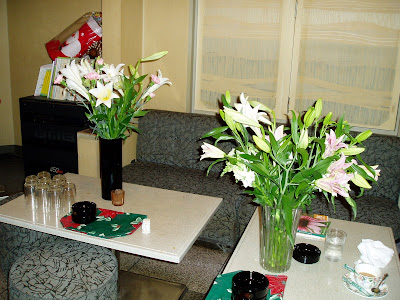Above: Coffee Shop/Karaoke Bar "Coffee and Sunak"
Long ago and far away in China I wrote a post about doing laundry, which at first seemed as though it would be hard, but turned out to be easy, like so many things in Beijing. The hardest thing to figure out was how to get the machine going: it turned out a kind of magnet shaped like a flat ice cream cone could be purchased at the front desk for a small deposit and charge per load - it cost about 36 cents to do one load of laundry. And it was really easy for me, because the machine was in a tiny room across the hall from my room - closer than the washing machine at home. I had it much easier than the students, because I had a cool arrangement in front of a large window with a bar (and hangers) that could be lowered and raised. In addition, it was warm, and often hot, in Beijing in September and October. It rained perhaps two days in eight weeks, and the clothes would dry in a day or less if they weren't very heavy. I even found Tide in the convenience store, and found I really wanted that perfume that smells like clean laundry they put into it. The heck with those fragrance-free brands: give me the chemicals that signal fresh linen. But I forgot the first time I did laundry to take the Kleenex out of my pocket, so I had a blue shirt polka-dotted with white and no dryer to remove it. After that I was more careful.
In Japan, I live in a beautiful house, but one that is not equipped with a washing machine. My host family, who live in the house adjacent to mine and who own both, pointed out the Coin Laundry a few blocks away. Most of the time it feels like my own personal laundry, with just two washers and two dryers. It costs 300 yen to wash and 100 yen per 10 minutes to dry, of course much more expensive than China, but at least I had dryers to use on rainy days in November and December - and in Kameoka it seems to rain several days a week, and always on Saturday and Sunday. I have no idea what laundromats cost in the U.S. these days, anyway. Most Japanese apartments and homes have washers, although dryers are much more rare: laundry hangs from most balconies even on rainy days, and most married women work only part time and do all the cooking and cleaning. Tonight was my last visit, I hope, to the Coin Laundry. And since I did it in the evening, I was able to take advantage of the "Coffee and Sunak" shop across the street from the laundry. I've passed it ten or eleven times, but it seemed not to be open during the day. It looked surprisingly European or American, sporting wrought iron chairs and tables outside, white lights, potted plants, and wreaths and vines decorating the painted white exterior. There is a reason why it's "Coffee and Sunak" - in Japanese there are never two consonant sounds together, so the "sn" of "snack" becomes "sunak," even if the "su" is elided so it really sounds like "snack." Similarly, "Spain," if written out sound by sound, would be "supein," but it's pronounced pretty similarly to the English "Spain."
So inside I went, dressed as always in my Beiwai sweatshirt and black pants. As soon as I entered I realized I was underdressed for this tiny but sophisticated bar/coffee shop. In fact, it turned out to really be a tiny karaoke bar. But I was the only patron, and the hostess, dressed beautifully in muted colors, like most women in Japan, brought me coffee in a pretty china cup with a little Venezualan chocolate on the side. I inquired about the "sunak" - perhaps I could eat something while my clothes spun in the washer and dryer - but no menu appeared and it didn't seem as though there was really any food to accompany the drinks. I pulled out the papers I was grading and settled in, wondering if a karaoke crowd would show up. But I was there pretty early, from 6:30 to about 7:15, and the only customer, so the hostess brought me two magazines, one the Members' Directory of the (British) Royal Horticultural Society and the other something very Martha Stewartish about English Kitchen Gardens, with pretty photos of thatch-roofed cottages and photos of recipes I'll never make, like crackers embedded with edible leaves and flowers. Apparently there were 1000 members of the Royal Horticultural Society in Japan, not surprising considering how many people in Japan are serious gardeners. We talked about our children and China, and I showed her that I had some of the same jazz tunes on my iPod that were playing, including one by Ella Fitzgerald and some Cole Porter.
After two serious cups of coffee I had that I-can-paint-the-house-and-write-a-book-before-l-go-to-bed feeling so I figured I'd better leave and watch the clothes rotate in the dryer before I got more caffeinated. Even so I was unable to complete the laundry without singing out loud along with the BeeGees on the iPod, safely enclosed and soundproofed in the capsule of the Coin Laundry.
 (Photo from About.Com: 20c History)
(Photo from About.Com: 20c History)















